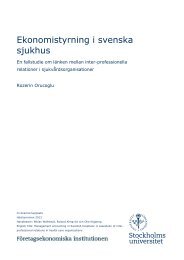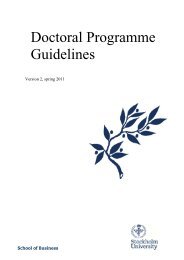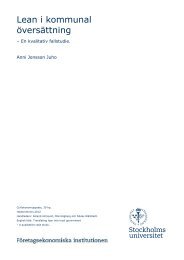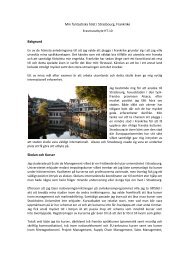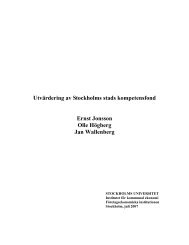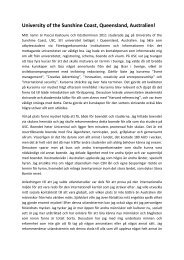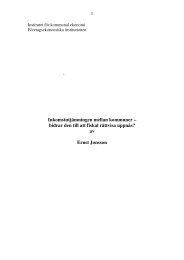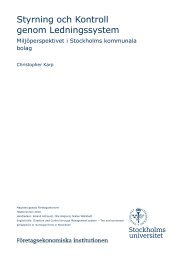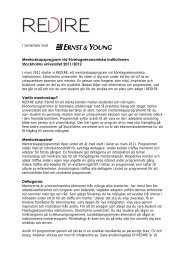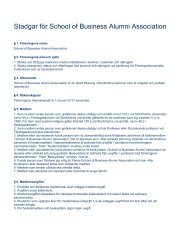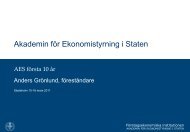Organizational Atmospheres: Foam, Affect and Architecture
Organizational Atmospheres: Foam, Affect and Architecture
Organizational Atmospheres: Foam, Affect and Architecture
Create successful ePaper yourself
Turn your PDF publications into a flip-book with our unique Google optimized e-Paper software.
<strong>Organizational</strong> <strong>Atmospheres</strong><br />
Christian Borch<br />
language’ (2005: 224). But this is intended since he believes that a new<br />
vocabulary is needed to account for social life. In the following parts of<br />
the article I seek to explore how organization theory may profit from this<br />
new language. I do so by analysing organizations as foam.<br />
<strong>Organizational</strong> <strong>Foam</strong><br />
How <strong>and</strong> with what implications may the sphere theory be applied to<br />
organizations? As the above quote indicates, Sloterdijk seems to conceive<br />
of organizations as micro-spherical bubbles that are part of the overall social<br />
foam. In my opinion, reducing organizations to singular bubbles underestimates<br />
their complexity. I will argue instead that each organization<br />
itself composes a foam structure with many bubbles or cells. This is not to<br />
suggest a fractal logic where each part mimes the whole (meaning in our<br />
case that each bubble is a foam of bubbles). Rather, the aim is to take seriously<br />
the complex nature of organizations <strong>and</strong> this requires that they are<br />
seen as foam composites.<br />
What do we get to see if we observe organizations as foam? I claim that<br />
a foam-theoretical view on organizations entails a unique combination of<br />
five dimensions. It is crucial to stress that, while each of the five dimensions<br />
may be found in various branches of existing organization theory,<br />
the significance of Sloterdijk’s work lies precisely in providing a theoretical<br />
vocabulary that integrates these dimensions <strong>and</strong> relates them to<br />
one another. What, then, are these dimensions? First, foam theory implies<br />
that we see organizations as complex composites that have no real centre.<br />
In foam, whether as physical substance or social entity, there is no core<br />
from which other bubbles emerge or to which they need relate. Rather,<br />
since no bubble is per definition more important than others, new bubbles<br />
may emerge from any part of the foam structure. Consequently, a foamtheoretical<br />
approach does not observe organizations from the view point of<br />
hierarchies, in terms of principal-agent relations or the like, but focuses,<br />
on the contrary, on how organizational sociality creates a foam structure<br />
of co-isolated bubbles where no cell has primacy. These cells or bubbles<br />
emerge as soon as a membrane has been created that provides meaning <strong>and</strong><br />
immunity to those who are surrounded by it. For example, individual offices<br />
or the various divisions of an organization may count as such bubbles.<br />
Second, since foam is at the centre of attention, the individual subjects<br />
<strong>and</strong> their capacities, interests <strong>and</strong> motives are not the analytical starting<br />
point. Third, it follows from the foam-theoretical perspective that the cells<br />
do not pursue some overall <strong>and</strong> common organizational goal. Rather, they<br />
are concerned with their own immunity strategies, i.e. strategies for preserving<br />
the fragile membrane of the cell. An example of such immunity<br />
strategies could be the ways in which employees use ‘hot nesting’ (Warren,<br />
2006) to create minor bubbles in the organization that imitate the domestic<br />
sphere <strong>and</strong> its safety <strong>and</strong> comfort (see also Dale <strong>and</strong> Burrell, 2008: 119).<br />
227<br />
Downloaded from<br />
org.sagepub.com at Stockholms Universitet on March 30, 2011



